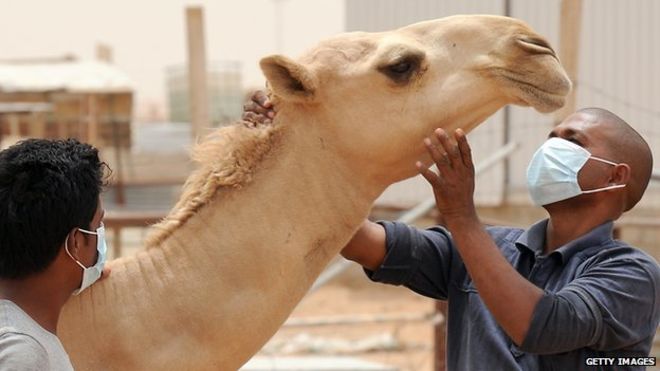Don’t drink that camel urine!

(BBC 2015)
In late summer of 2015, University of Pennsylvania announced a study of a synthetic DNA vaccine that could potentially be used on both camels and humans in the near future.
“Everyone should know this stuff” Level
Remember the hype about the disease called MERS last summer that faded away quickly? What was all the hype about and what happened to the research with the disease? MERS is a shortened term for Middle Eastern Respiratory Syndrome, and is a coronavirus that was discovered in 2012 in the Middle East (Reznick 2015). In his article, Alisa Reznick states that MERS is a virus inside the coronavirus family which causes symptoms similar to those of a common cold (Reznick 2015). The symptoms of MERS include fever, cough, and shortness of breath, which is very similar to those of the common cold or an influenza (CDC).
The mystery behind this syndrome is the fact that the disease is very easy to misdiagnose. It is easy to mistake the virus for the common cold and let the patient go around transmitting the virus to others (McIntosh 2015).
The consequences of misunderstanding the virus has been especially highlighted by the recent outbreak in South Korea. James McIntosh, a writer for the Medical News Today and a former worker of the British National Health Service, says that the reason behind the rapid spread of MERS in South Korea is mainly due to the first patient visiting numerous healthcare facilities without being fully diagnosed with MERS (McIntosh 2015). After the MERS virus had spread for quite a while, Korea set strict boundaries regarding quarantine that affected more than 16,000 people, and gave control guidelines to the public (McIntosh 2015). This only increased the fear of the ‘unknown’ virus (McIntosh 2015).
Although the outbreak in South Korea seemed very severe, McIntosh made it known that the numbers are not high compared to previous outbreaks in the Middle East, as 85% of the reported cases of MERS are still from the middle east (McIntosh 2015). It is said that the fear of MERS that developed from Korea’s outbreak has led Korean citizens to overestimate the infectiousness and severity of the disease (McIntosh 2015). MERS is easy to regulate once an effective infection control, consisting of better quarantine and diagnosis methods, is set up (McIntosh 2015). The severity of the outbreak in South Korea was due to the lack of such control (McIntosh 2015).
Many universities and researchers are still in the middle of gathering more information about the transmission and the prevention of the disease. In the late summer of 2015, University of Pennsylvania announced a study of a synthetic DNA vaccine that could potentially be used on both camels and humans in the near future (Reznick 2015). Georgetown scholar Daniel Lucey and the Jordan Ministry of Health believe that a specific cure is still needed due to how uncontrollable the transmission of the disease is (Reznick 2015).
“For geniuses only” Level
So how close are the researchers to finding the reason for the outbreak? Well, researchers have already found the most prevalent source of transmission of the MERS virus: camels (Deem 2015). The fact that the disease started in the Middle East, and the fact that the initial patients all contacted camels before contracting the disease gave the researchers this starting point (Deem 2015).
According to Sharon Deem, the study on the Kenyan camels’ exposure to MERS-CoV virus was conducted in 2013 (Deem 2015). The study was conducted in order to understand the epidemiology of the virus in suspected camel populations and to prevent human transmissions (Deem 2015). They separated the camels into testing groups based on their herds and checked the existence of the MERS-CoV antibody (Deem 2015). Camels that have the MERS-CoV antibody are not affected as severely as humans, but keep the antibodies forever and transmit them to other organisms (Deem 2015).
According to Deem, the test result showed that 46.8% of the tested camel population had MERS-CoV antibodies in their blood (Deem 2015). On top of that, at least one camel of each herd was antibody positive (Deem 2015). The seroprevalence rate, or the percentage of antibody-positive camels in a population, was similar for all tested groups (Deem 2015). This proves that all camels (at least all Kenyan camels), regardless of age or internal factors, are equally susceptible to the MERS-CoV (Deem 2015). The test result also showed that individual camels that frequently contacted other camels in different herds were more likely to pass on the antibody to others, which proves that contact is a method of the antibody’s transmission (Deem 2015). This result explains how MERS arrived in South Korea. It was found that the first man who contracted MERS had been traveling in the middle east and consuming camel meat before he brought the disease back to Korea (McIntosh 2015).
The results of the study confirm the suspicion that camels were key animals in transmitting the MERS-CoV virus to the human population (Deem 2015). This has pushed the scientific community into conducting different studies that carefully look at the molecular details behind the transmission (Deem 2015).
Along with the studies regarding the virus’ transmission, scientists have also been conducting studies to find a cure for the virus. Researchers at Purdue University have been studying ways to stop MERS from being so threatening, and announced their studies while South Korea’s outbreak created a buzz in the world (Purdue 2015).
According to the Purdue research team, one effective way to stop MERS’ spread is to inhibit one of the virus’s enzymes that enable its replication (Purdue 2015). The research team set a 3C-like protease as its main target of inhibition, but got unexpected results that differed from studies of the same process in the SARS or other coronaviruses (Purdue 2015). Although high doses of the inhibitor in the protease did stop the virus from replicating, the team also found out that low doses of the inhibitor could entice more replication of MERS, which counteracted the desired result (Purdue 2015). Purdue believes that this discovery can be used effectively to further research in stopping MERS virus and coming up with a vaccine (Purdue 2015).
Impress your friends and family with these three related facts:
Fact 1: Since 2012, only 26 countries have reported cases of MERS-CoV (CDC 2015).
Fact 2: Since September 2012, 1,638 cases of MERS-CoV were laboratory-confirmed, and 587 deaths were notified (CDC 2015).
Fact 3: No vaccine or specific treatment for this disease is available on the market (CDC 2015).
Author: This article was created by Agnes Choi, a senior at Choate Rosemary Hall in Wallingford, CT. Agnes’s spirit animal is a crow tit. Someday, Agnes will be famous for winning a world-wide sleeping contest.

Works Cited
Centers for Disease Control and Prevention (2016). Middle East Respiratory Syndrome (MERS). Centers for Disease Control and Prevention. Accessed February 1, 2016. http://www.cdc.gov/coronavirus/mers/index.html
Deem, Sharon (2015). “Serological Evidence of MERS-CoV Antibodies in Dromedary Camels (Camelus dromedaries) in Laikipia County, Kenya.” PLOS One. Published October 16, 2015. Accessed January 29, 2016. http://journals.plos.org/plosone/article?id=10.1371/journal.pone.0140125
McIntosh, James (2015). “Assessing the South Korea MERS outbreak: could it happen elsewhere?” Medical News Today. Last modified July 30, 2015. Last accessed February 4, 2016. http://www.medicalnewstoday.com/articles/297535.php
Purdue University (2015). “Researchers successfully target ‘Achilles’ heel’ of MERS virus”. ScienceDaily. Last modified June 22, 2015. Accessed February 3, 2016 http://www.sciencedaily.com/releases/2015/06/150622124711.htm
Reznick, Alisa (2015). “The Middle East’s Mystery Virus”. Public Broadcasting System. Last modified September 23, 2015. Accessed January 26, 2016. http://www.pbs.org/wgbh/nova/next/body/mers-jordan/
World Health Organization (2016). Middle East Respiratory Syndrome Coronavirus (MERS-CoV) Facts. World Health Organization. Accessed February 1, 2016. http://www.who.int/mediacentre/factsheets/mers-cov/en/

Leave a Reply